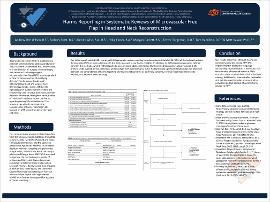| dc.contributor.author | Wilson, Andrew Dee | |
| dc.contributor.author | Ernst, Zachary | |
| dc.contributor.author | Wise, Audrey | |
| dc.contributor.author | Flores, Holly | |
| dc.contributor.author | Garrett, Morgan | |
| dc.contributor.author | Torgerson, Trevor | |
| dc.contributor.author | Hamilton, Tom | |
| dc.contributor.author | Vassar, Matt | |
| dc.date.accessioned | 2023-11-02T20:45:50Z | |
| dc.date.available | 2023-11-02T20:45:50Z | |
| dc.date.issued | 2023-02-17 | |
| dc.identifier | ouhd_Wilson_harmsreportinginsystematicreviews_2023 | |
| dc.identifier.citation | Wilson, A. D., Ernst, Z., Wise, A., Flores, H., Garrett, M., Torgerson, T., Hamilton, T., and Vassar, M. (2023, February 17). Harms reporting in systematic reviews of microvascular free flap in head and neck reconstruction. Poster presented at Research Week, Oklahoma State University Center for Health Sciences, Tulsa, Ok. | |
| dc.identifier.uri | https://hdl.handle.net/11244/339893 | |
| dc.description.abstract | Objective: To evaluate harms reporting in systematic reviews of microvascular free flap in head and neck reconstruction. | |
| dc.description.abstract | Data Sources: This cross-sectional analysis included searches from the following major databases from 2012 to June 1, 2022: MEDLINE (Pubmed and Ovid), Embase, Epistemonikos, and the Cochrane Database of Systematic Reviews. | |
| dc.description.abstract | Review Methods: In a masked duplicate manner, screening was performed using Rayyan, and data was extracted using a pilot-tested Google form. AMSTAR-2 was used to appraise the methodological quality of reviews, and Corrected Covered Area was calculated to detect primary study overlap across all reviews. Reviews were then grouped in pairs of two, called dyads, and Corrected Covered Area was calculated again for each individual dyad. Dyads with high overlap (≥50%) were further investigated for accuracy of harms reporting. | |
| dc.description.abstract | Results: Our initial search yielded 268 records, with 50 systematic reviews meeting inclusion criteria. A total of 46 (92%) of the included reviews demonstrated 50% or more adherence to the items assessed in our harms checklist. Our Corrected Covered Area tool revealed 0.6% primary study overlap across all reviews, and one dyad with high overlap (≥ 50%). No statistically significant relationship was observed between the completeness of harms reporting and reviews listing harms as a primary outcome, reviews reporting adherence to PRISMA, or a review’s AMSTAR rating. | |
| dc.description.abstract | Conclusion: This study identifies how harms reporting in systematic reviews of microvascular free flap reconstruction of the head and neck can be improved and provides suggestions with potential to mitigate the paucity in current literature. | |
| dc.format | application/pdf | |
| dc.language | en_US | |
| dc.publisher | Oklahoma State University Center for Health Sciences | |
| dc.rights | The author(s) retain the copyright or have the right to deposit the item giving the Oklahoma State University Library a limited, non-exclusive right to share this material in its institutional repository. Contact Digital Resources and Discovery Services at lib-dls@okstate.edu or 405-744-9161 for the permission policy on the use, reproduction or distribution of this material. | |
| dc.title | Harms reporting in systematic reviews of microvascular free flap in head and neck reconstruction | |
| osu.filename | ouhd_Wilson_harmsreportinginsystematicreviews_2023.pdf | |
| dc.type.genre | Presentation | |
| dc.type.material | Text | |
